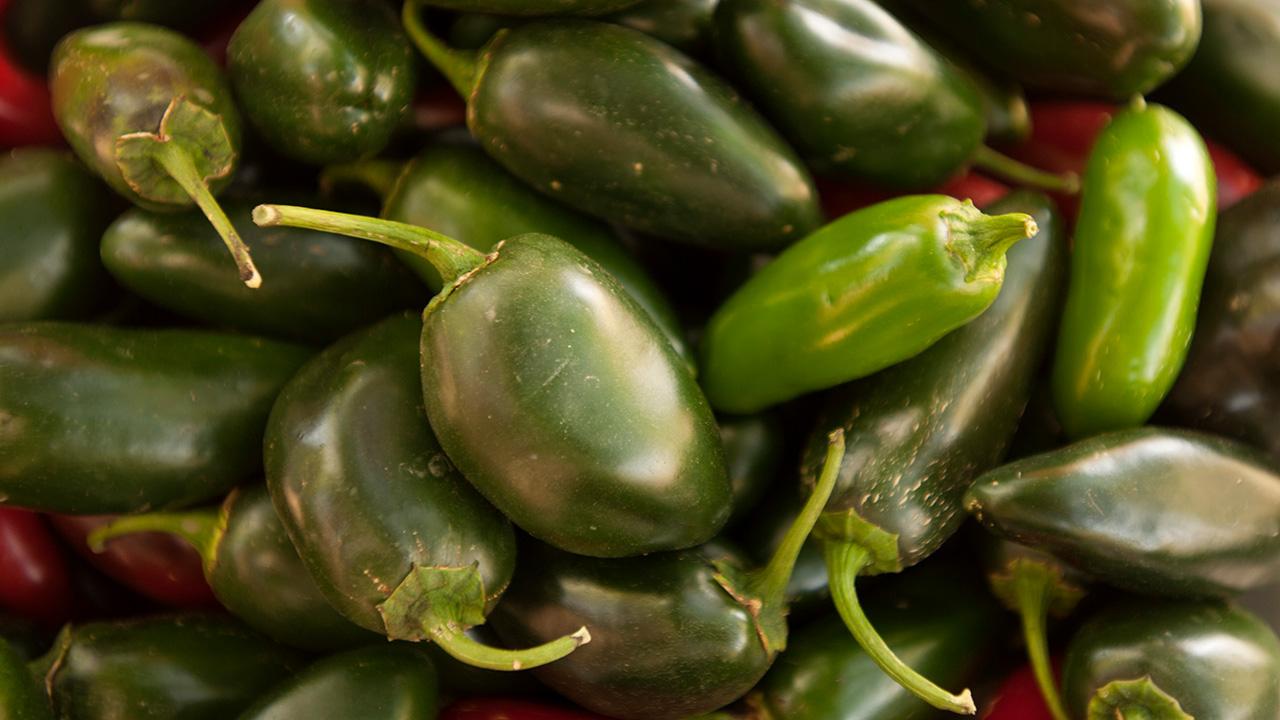
Beans, peppers and alfalfa win grants from NIFA
Research deals with labor shortages, offers climate resilience
Scientists in the UC Davis Department of Plant Sciences have landed $2.1 million in federal grants to develop varieties of green beans, chile peppers and alfalfa that can offer farmers greater quality, lower production costs and better yield amid the growing heat and drought already happening with climate change.
The grants from the United States Department of Agriculture come through the National Institute of Food and Agriculture’s Agriculture and Food Research Initiative.
Research will focus on developing better varieties of snap beans, chile peppers destined for processing, and alfalfa. The three grants are in addition to an $800,000 NIFA grant announced earlier this year to develop new cultivars of bread-quality triticale.
Parker and Gepts: How to keep green beans tender?
Travis Parker and Paul Gepts will look for the genes that control the snappiness of green bean pods. NIFA granted them $650,000 for the work over four years, starting in September. Parker is an assistant professional researcher and works in the lab of Gepts, a distinguished professor emeritus.
The fiber of bean pods is important for harvesting in some varieties -- think pinto or kidney. It allows the beans to separate easily from the pod at harvest. But in green beans, too much fiber makes the pods tough. So, green beans are bred to have tender pods; but about one in 100 green bean plants will spontaneously revert to its tough, stringy, ancestral state. That trait gets passed on through the seeds, and it happens enough that seed companies spend about $50,000 per variety every year, by each company, to preventively test their seeds. Making things more complicated, the high temperatures and drought coming from climate change tell some bean plants to lay on the fiber, while others are unaffected.
Parker and Gepts believe their work can make green beans tender more consistently, saving farmers time and money. They plan to study bean genetics to find how the pod is built and why some spontaneously revert to being tough. They’ll look for plants that produce tender pods despite heat and drought, and which can pass on those qualities through their seeds with greater stability than what is currently available. They'll also initiate a pre-breeding program.
“The results of this study will reduce seed production costs, improve product quality, promote climate change resilience and greatly facilitate breeding in a nutritious and broadly consumed vegetable crop,” the scientists wrote in their proposal.
Van Deynze and Hill: Mechanical harvesting of peppers to expand with new varieties
Allen Van Deynze, Theresa Hill and team will look for genes in chile peppers that control how the plant is built and how easily the stem separates from the fruit. Their goal: develop varieties good for processing that can be harvested by machine. NIFA granted them $800,000 over three years, starting in March. Van Denyse is director of the UC Davis Seed Biotechnology Center; and Hill is a research specialist at the center.
Most peppers in the United States are picked by hand and, for processing, peppers also need the stems removed by hand. Those two steps can account 20 percent to 50 percent of production costs, Hill wrote. That makes it difficult for American products to compete with countries that have lower labor costs.
The team will develop breeding lines of green jalapeño and New Mexico chile destined for processing. They hope to combine easy destemming with plant structure and uniformity that are good for machine harvesting ̶ generally, with an upright build and fruit that forms in the upper part of the plant. The fruit must also taste delicious. They expect their research could eventually be applied to other chile varieties and more vegetables.
In addition, they will turn the project into a learning experience for undergraduate and high school students. Their outreach will include addressing minorities and small to medium farms.
People have been experimenting with mechanical harvesters for decades, but those machines need plants with the right structure to avoid losing a large amount of vegetable during the harvest.
“We are working with stakeholders, state commodity boards, growers, processors and seed companies that identified this project as a critical need,” Van Deynze and Hill wrote in their proposal. Colleagues at New Mexico State University also will participate in the project.
Brummer and Monroe seek more alfalfa per acre
Charlie Brummer and Grey Monroe will look for the genes that control how big alfalfa grows and ways to use that knowledge to increase yield. NIFA granted them $650,000 over three years, starting in July. Brummer is a professor and director of the UC Davis Center for Plant Breeding; Monroe is an assistant professor and head of the Genomics of Climate Adaptation Lab.
As part of their work, they plan to sequence the genome of falcata, a yellow-flowering variety that thrives despite drought and cold, is good for winter cropping and rangeland planting, and causes less bloat in livestock.
In addition, their work will dig deeper into a process called segregation distortion, which affects how genetic information is passed from one generation to the next. From that knowledge, they hope to figure out more effective ways to breed plants for higher yield.
Alfalfa, Medicago sativa L., is the most important forage crop and fourth-most-valuable field crop in the U.S., valued at about $8.8 billion yearly. It also has important environmental benefits, according to the U.S. Department of Agriculture. But yield has been increasing only slowly, Brummer and Monroe noted in their proposal.
Media Resources
- Trina Kleist, UC Davis Department of Plant Sciences, tkleist@ucdedavis.edu, (530) 601-6846
